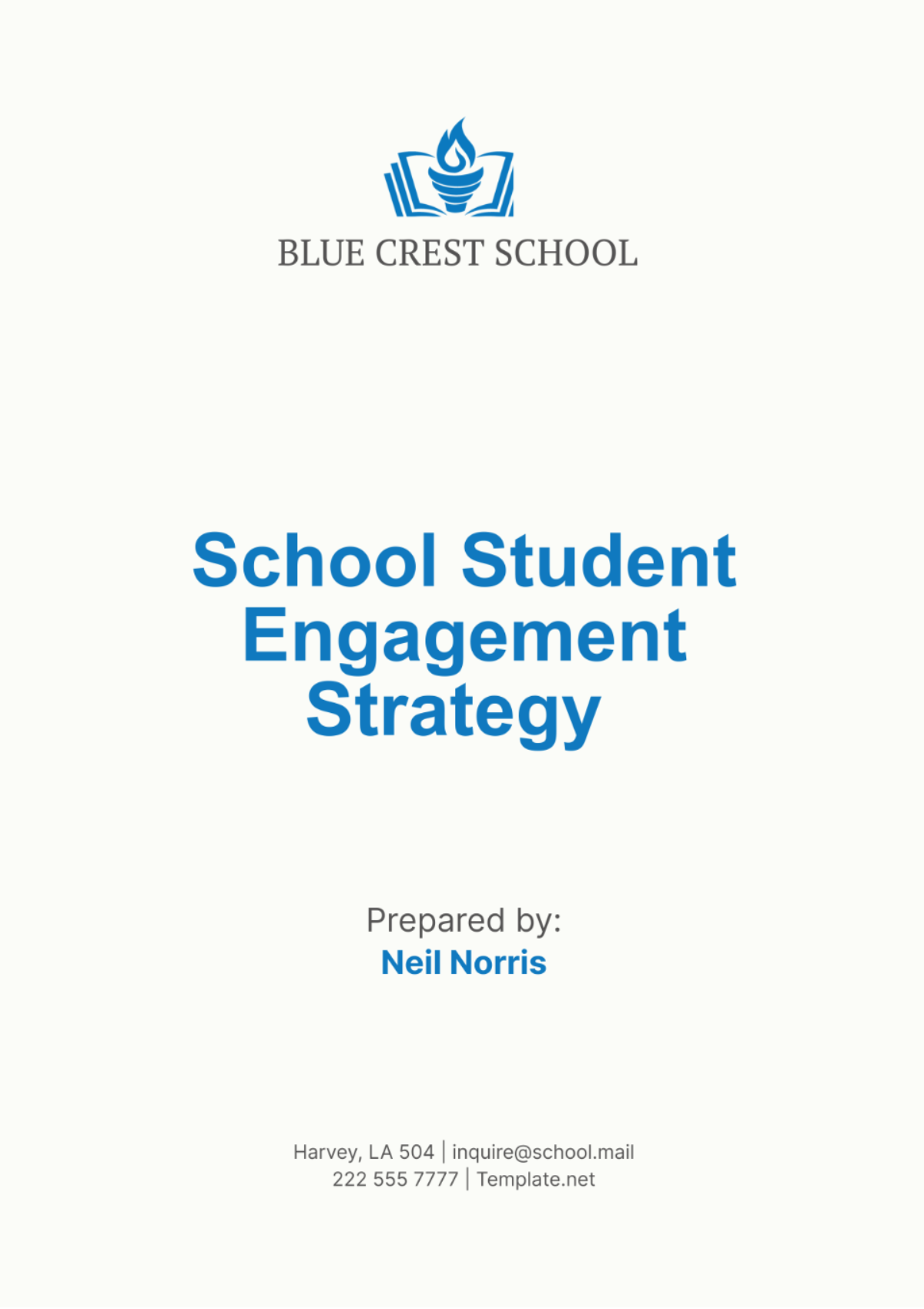Free School Student Engagement Strategy

I. Introduction
A. Purpose of the Strategy
The [Your Company Name] School Student Engagement Strategy is designed to foster a supportive and enriching environment where every student feels valued, motivated, and actively involved in their educational journey. This strategy outlines the comprehensive approaches and methods we will employ to enhance student engagement across academic, social, and emotional dimensions.
B. Importance of Student Engagement
Student engagement is critical to academic success and personal development. Engaged students are more likely to perform well academically, exhibit positive behavior, and develop essential life skills. By actively involving students in their learning process and school activities, we aim to cultivate a sense of belonging and purpose, which are fundamental for their overall growth and well-being.
C. Overview of the Strategy Components
The [Your Company Name] School Student Engagement Strategy encompasses several key components, including understanding student engagement, setting goals and objectives, implementing effective engagement strategies, and monitoring and evaluating the progress. Each component is designed to address different aspects of student engagement to create a holistic approach that benefits all students.
II. Understanding Student Engagement
A. Definition and Key Elements of Student Engagement
Student engagement refers to the level of interest, enthusiasm, and commitment that students show towards their learning and school activities. It includes three main elements: academic engagement, social engagement, and emotional engagement. Academic engagement involves students' active participation in learning activities, social engagement relates to their involvement in the school community and extracurricular activities, and emotional engagement pertains to their feelings of connection and support within the school environment.
B. Benefits of Student Engagement
Engaged students are more likely to achieve higher academic performance, exhibit positive behaviors, and develop essential social and emotional skills. The benefits of student engagement extend beyond the classroom, fostering critical thinking, resilience, and a lifelong love of learning. Moreover, engaged students tend to have better attendance rates, lower dropout rates, and are more likely to pursue higher education and career opportunities.
C. Factors Influencing Student Engagement
Several factors influence student engagement, including the quality of teacher-student relationships, the relevance and challenge of the curriculum, the availability of extracurricular activities, and the overall school climate. Personal factors such as students' interests, goals, and learning styles also play a significant role. By addressing these factors, [Your Company Name] aims to create a supportive environment that encourages active and sustained engagement.
III. Goals and Objectives
A. Short-Term Goals
In the short term, [Your Company Name] aims to implement immediate strategies to boost student engagement. These include increasing student participation in classroom activities, enhancing teacher-student interactions, and providing a variety of extracurricular opportunities. Our specific objectives for the first year include:
Increasing student participation in classroom discussions by 20%
Implementing at least five new extracurricular programs
Providing professional development for teachers on engagement techniques
B. Long-Term Goals
Our long-term goals focus on sustaining and deepening student engagement over several years. These goals include developing a school culture that prioritizes student voice and choice, integrating technology to enhance learning experiences, and building robust support systems for students' social and emotional needs. Our objectives for the next five years include:
Establishing a student advisory council to give students a voice in school decisions
Achieving a 95% student participation rate in at least one extracurricular activity
Implementing a comprehensive mental health support program
C. Key Performance Indicators (KPIs)
To measure the success of our engagement strategy, we will track various KPIs. These include attendance rates, academic performance metrics, student survey results, and participation rates in extracurricular activities. Regular analysis of these indicators will help us adjust our strategies and ensure continuous improvement.
KPI | Target |
|---|---|
Attendance Rate | 95% |
Academic Performance | 10% increase in test scores |
Student Survey Satisfaction | 90% positive feedback |
Extracurricular Participation | 80% student involvement |
IV. Engagement Strategies and Approaches
A. Academic Engagement
Academic engagement is at the core of our strategy. It involves creating an interactive and stimulating learning environment that encourages active participation and fosters a love of learning.
Interactive Teaching Methods
We will adopt interactive teaching methods such as collaborative projects, problem-based learning, and hands-on activities. These methods not only make learning more engaging but also help students develop critical thinking and problem-solving skills. Teachers will be trained to incorporate these techniques into their lesson plans and adapt them to meet the diverse needs of students.
Use of Technology in Classrooms
Technology plays a crucial role in enhancing academic engagement. By integrating digital tools and resources, we can create more dynamic and personalized learning experiences. Students will have access to online learning platforms, educational apps, and interactive simulations that complement traditional teaching methods. Additionally, we will provide ongoing training for teachers to effectively use technology in their classrooms.
Personalized Learning Plans
Personalized learning plans will be developed for each student, taking into account their individual strengths, interests, and learning styles. These plans will outline specific goals and strategies tailored to each student's needs, ensuring that they remain engaged and motivated. Regular assessments and feedback will help track progress and make necessary adjustments to the plans.
B. Social Engagement
Social engagement is essential for building a sense of community and belonging within the school. It involves providing opportunities for students to interact, collaborate, and contribute to the school environment.
Extracurricular Activities
A wide range of extracurricular activities will be offered to cater to diverse interests and talents. These activities include sports, arts, music, debate clubs, and community service projects. Participation in these activities helps students develop teamwork, leadership, and social skills while fostering a sense of belonging and school pride.
Peer Mentoring Programs
Peer mentoring programs will be established to promote positive relationships and provide support for students. Older students will be paired with younger students to offer guidance, encouragement, and academic assistance. This mentorship fosters a supportive and inclusive school culture, enhancing social engagement and creating lasting connections.
Community Service Initiatives
Community service initiatives will be integrated into the school curriculum to encourage students to give back to their communities. These initiatives provide valuable learning experiences and help students develop empathy, responsibility, and a sense of civic duty. Through partnerships with local organizations, students will have opportunities to participate in various service projects throughout the year.
C. Emotional Engagement
Emotional engagement involves creating a supportive environment where students feel safe, valued, and understood. It focuses on building strong relationships and promoting mental and emotional well-being.
Building Strong Teacher-Student Relationships
Strong teacher-student relationships are fundamental to emotional engagement. Teachers will be encouraged to take an interest in their students' lives, listen to their concerns, and provide consistent support and encouragement. Regular one-on-one check-ins and open communication channels will help build trust and rapport.
Promoting a Positive School Culture
A positive school culture is characterized by respect, inclusivity, and mutual support. We will promote this culture through school-wide initiatives, such as anti-bullying campaigns, diversity celebrations, and recognition programs that highlight students' achievements and contributions. Creating a welcoming and inclusive environment is key to emotional engagement.
Support Services for Mental Health and Well-being
Comprehensive support services will be available to address students' mental health and well-being. These services include counseling, stress management workshops, and peer support groups. By providing these resources, we aim to help students navigate challenges, build resilience, and maintain a healthy balance between academic and personal life.
V. Implementation Plan
A. Timeline and Phases
The implementation of the [Your Company Name] School Student Engagement Strategy will be carried out in phases over the course of several years. Each phase will focus on specific components of the strategy, allowing for gradual and sustainable development.
Phase | Focus Areas | Duration |
|---|---|---|
Phase 1 | Initial assessment, professional development, and pilot programs | Year 1 |
Phase 2 | Full implementation of academic, social, and emotional engagement strategies | Years 2-3 |
Phase 3 | Expansion of programs, continuous monitoring, and evaluation | Years 4-5 |
B. Roles and Responsibilities
Successful implementation of the strategy requires collaboration and commitment from all members of the school community. Clear roles and responsibilities will be assigned to ensure accountability and effective coordination.
Role | Responsibilities |
|---|---|
School Leadership | Oversee implementation, allocate resources, and provide strategic direction |
Teachers | Implement engagement strategies in classrooms, participate in professional development |
Counselors and Support Staff | Provide mental health services, coordinate peer mentoring programs |
Students | Participate in engagement activities, provide feedback on initiatives |
Parents and Community Members | Support school initiatives, participate in community service projects |
C. Resource Allocation
Adequate resources will be allocated to support the various components of the engagement strategy. This includes funding for professional development, technology, extracurricular programs, and support services. Additionally, partnerships with local organizations and community members will be leveraged to provide additional resources and support.
VI. Monitoring and Evaluation
A. Data Collection Methods
Monitoring and evaluating the effectiveness of the [Your Company Name] School Student Engagement Strategy is essential to ensure continuous improvement and success. We will employ a variety of data collection methods to gather comprehensive information about student engagement levels, the impact of implemented strategies, and areas that require enhancement.
Surveys and Questionnaires
Regular surveys and questionnaires will be administered to students, teachers, and parents to gather feedback on engagement initiatives. These tools will help us understand perceptions, experiences, and satisfaction levels related to various engagement activities. The surveys will include questions on academic engagement, social interaction, emotional well-being, and overall school climate.
Observations and Assessments
Classroom observations and assessments will be conducted to evaluate the effectiveness of teaching methods and engagement strategies. Teachers will use standardized observation tools to record student participation, interaction, and engagement during lessons. These observations will provide valuable insights into the practical application of engagement techniques and their impact on student learning.
Academic and Behavioral Data
Academic and behavioral data, such as attendance records, grades, and disciplinary reports, will be analyzed to identify trends and correlations with engagement levels. By examining this data, we can determine the effectiveness of our strategies in improving academic performance, reducing absenteeism, and promoting positive behavior.
B. Analysis and Reporting
The collected data will be systematically analyzed to identify strengths, weaknesses, and opportunities for improvement. Various statistical methods and data visualization tools will be used to interpret the data and present it in a comprehensible manner. Regular reports will be generated to communicate findings to stakeholders and guide decision-making.
Key Metrics and Indicators
To measure the success of the engagement strategy, we will track key metrics and indicators. These include:
Student attendance rates
Academic performance (grades, test scores)
Participation in extracurricular activities
Student, teacher, and parent satisfaction levels
Metric | Target |
|---|---|
Attendance Rate | 95% |
Academic Performance | 10% increase in test scores |
Extracurricular Participation | 80% student involvement |
Satisfaction Levels | 90% positive feedback |
C. Feedback Mechanisms
Effective feedback mechanisms are crucial for ongoing improvement. We will establish multiple channels for students, teachers, and parents to provide feedback on engagement initiatives. This includes suggestion boxes, online feedback forms, and regular focus group discussions. Constructive feedback will be used to refine strategies and address any emerging issues promptly.
VII. Professional Development for Staff
A. Training Programs
Professional development for staff is a key component of the [Your Company Name] School Student Engagement Strategy. Training programs will be designed to equip teachers and support staff with the knowledge and skills necessary to implement effective engagement strategies.
Interactive Workshops
Interactive workshops will be conducted to introduce teachers to innovative teaching methods, classroom management techniques, and technology integration. These workshops will be hands-on and participatory, allowing teachers to practice new skills and receive feedback from peers and trainers.
Online Courses and Webinars
Online courses and webinars will be offered to provide flexible learning opportunities for staff. These courses will cover a range of topics related to student engagement, including differentiated instruction, social-emotional learning, and the use of digital tools in education. Staff can access these resources at their convenience, allowing for continuous professional growth.
Workshops and Seminars
Regular workshops and seminars will be organized to facilitate collaborative learning and knowledge sharing among staff. These events will focus on specific aspects of student engagement, such as building positive relationships, fostering inclusive classrooms, and promoting student voice. Guest speakers and experts in the field of education will be invited to share their insights and best practices.
B. Collaborative Planning Sessions
Collaborative planning sessions will be held to encourage teamwork and shared responsibility for student engagement. Teachers and support staff will work together to develop lesson plans, design engagement activities, and create individualized learning plans for students. These sessions will foster a sense of community and collective ownership of the engagement strategy.
Training Component | Frequency |
|---|---|
Interactive Workshops | Quarterly |
Online Courses and Webinars | Ongoing |
Workshops and Seminars | Biannually |
Collaborative Planning Sessions | Monthly |
VIII. Involving Parents and the Community
A. Parent-Teacher Communication
Effective communication between parents and teachers is essential for fostering student engagement. [Your Company Name] will implement various strategies to ensure open and consistent communication channels.
Regular Updates and Newsletters
Regular updates and newsletters will be sent to parents to keep them informed about school activities, upcoming events, and student progress. These communications will highlight engagement initiatives, provide tips for supporting student engagement at home, and encourage parental involvement in school activities.
Parent-Teacher Conferences
Scheduled parent-teacher conferences will provide opportunities for face-to-face communication and collaboration. During these conferences, teachers will discuss student progress, share engagement strategies, and seek input from parents on how to further support their child's learning and development. These meetings will help build strong partnerships between parents and the school.
B. Community Partnerships
Building partnerships with community organizations and businesses is vital for enhancing student engagement. [Your Company Name] will actively seek collaborations that provide additional resources, opportunities, and support for students.
Service-Learning Projects
Service-learning projects will be developed in partnership with local organizations. These projects will allow students to apply their learning in real-world contexts while contributing to their community. Examples include environmental clean-up initiatives, assisting at local shelters, and participating in community health awareness campaigns.
Guest Speakers and Mentors
Community members will be invited to serve as guest speakers and mentors, sharing their expertise and experiences with students. These interactions will provide students with valuable insights into various careers, inspire them to pursue their passions and offer guidance and support from trusted role models.
C. Volunteer Opportunities
Volunteer opportunities will be created to encourage parents and community members to actively participate in school activities. This includes assisting with extracurricular programs, supporting classroom activities, and contributing to school events. Volunteer involvement enhances the sense of community within the school and provides additional support for student engagement initiatives.
Involvement Strategy | Frequency |
|---|---|
Regular Updates and Newsletters | Monthly |
Parent-Teacher Conferences | Biannually |
Service-Learning Projects | Ongoing |
Guest Speakers and Mentors | Quarterly |
Volunteer Opportunities | Ongoing |
IX. Conclusion
A. Recap of Key Points
The [Your Company Name] School Student Engagement Strategy is a comprehensive plan designed to enhance student engagement across academic, social, and emotional dimensions. By understanding the key elements of student engagement, setting clear goals and objectives, implementing effective strategies, and continuously monitoring and evaluating progress, we aim to create a supportive and enriching environment for all students.
B. Future Outlook
As we move forward, [Your Company Name] will remain committed to fostering a culture of engagement and continuous improvement. We will adapt our strategies based on feedback and data, ensuring that we meet the evolving needs of our students. Our long-term vision is to create a school community where every student feels valued, motivated, and empowered to achieve their full potential.
C. Call to Action for Continuous Improvement
We invite all members of the [Your Company Name] school community—students, teachers, parents, and community partners—to actively participate in our engagement initiatives. By working together, we can create a vibrant and dynamic learning environment that supports the academic and personal growth of every student. Let us commit to continuous improvement, celebrate our successes, and strive for excellence in all aspects of student engagement.
- 100% Customizable, free editor
- Access 1 Million+ Templates, photo’s & graphics
- Download or share as a template
- Click and replace photos, graphics, text, backgrounds
- Resize, crop, AI write & more
- Access advanced editor
Enhance student participation with Template.net's customizable and editable School Student Engagement Strategy Template. Use the AI Editor Tool to develop a tailored strategy for your school. Ensure effective student engagement and participation with this user-friendly template.





























